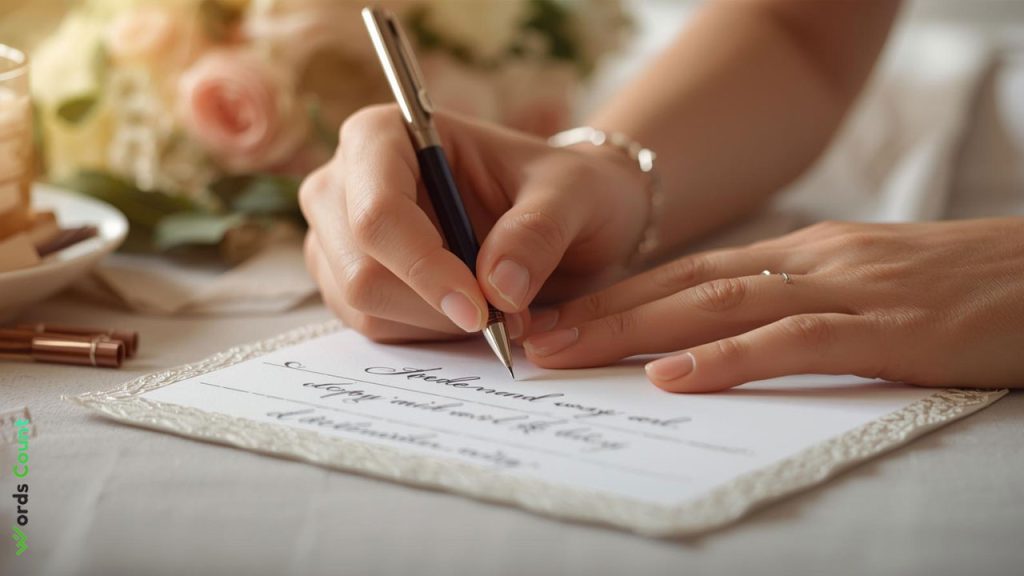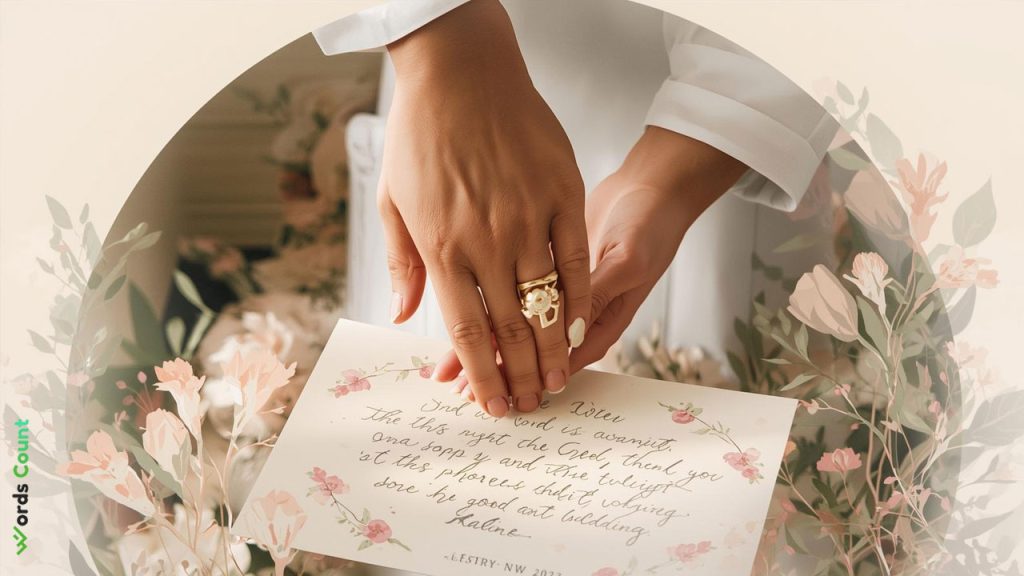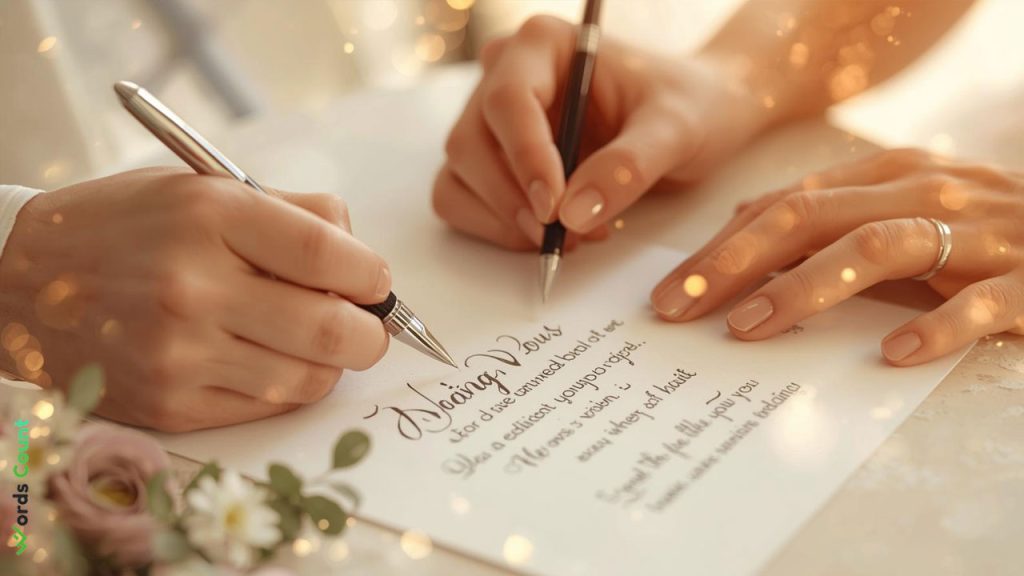Writing your own wedding vows can feel both exciting and scary. You want your words to sound real, loving, and personal. You want your partner (and your guests) to feel the meaning behind each promise. In this article, you will find a clear, easy-to-follow path. I’ll explain how to write wedding vows at a grade-5 reading level, in a friendly tone, and in a way that also works well for search engines like Google and Bing. Let’s dive in.
Why Write Your Own Vows?

Writing your own vows makes your ceremony more personal and meaningful. When you speak words you chose, your partner hears your heart. Also, custom vows let you share memories, hopes, and promises that matter especially to the two of you. Many couples today choose this option for its emotional impact.
But writing vows is also an act of care. It shows you’ve thought deeply about your relationship. That thoughtfulness will come through in your words.
Step 1: Prepare Your Heart and Mind
Set aside time
Don’t try to write your vows the night before. Give yourself several weeks. The best ideas often come slowly, after thinking and reflecting.
Create a quiet space
Find a calm place — maybe in your bedroom, a park bench, or a quiet corner. Bring paper or your computer. Play soft music if it helps you relax.
Gather your thoughts
Ask yourself questions like:
When did I first feel love or connection?
What qualities does my partner have that I deeply admire?
What times have brought us closer?
What promises do I truly want to keep for life?
What dreams do I have for us together?
Write down any words, short phrases, or memories you recall. Later, you will pick the best ones to include.
Step 2: Talk with Your Partner First
Before either of you writes a word, it’s wise to talk. You can share:
The tone you prefer (serious, light, funny, mixed)
How long your vows will be (one minute? two minutes?)
Whether you’ll show your vows before the ceremony
Any topics you want to include or avoid
This way, your vows won’t feel mismatched. It will help your wedding ceremony flow better.
Step 3: Choose a Structure (Outline) for Your Vows
Having a structure helps your vows feel organized. Here’s a simple outline you can follow. You may adjust it to suit your style:
| Section | Purpose | What to Include |
|---|---|---|
| 1. Opening / Address | Begin directly and warmly | Name or nickname of your partner; how they feel to you now |
| 2. What You Love / Admire | Show why you chose them | Qualities, traits, things they do |
| 3. Memory / Story | Make it personal | A moment or event that reveals your bond |
| 4. Promises | This is the core | 3 to 6 promises (serious or light) |
| 5. Vision of Future Together | Speak of hope | Dreams, plans, life ahead |
| 6. Closing / Final Statement | End with power | “I love you,” or a promise that ties everything together |
This structure reflects many vow-writing guides. Wedding Words+2Brides+2
Step 4: Write the Promises (The Vows Themselves)
Your promises are the “vows” part — what you pledge to do in the future. Here’s how to make them powerful:
How many promises?
Aim for 3 to 6 promises. Too many can dilute the impact. Wedding Words+1
Be specific and realistic
Avoid vague statements like “always” or “never,” because life has its ups and downs. Instead, use wording like:
“I promise to support your dreams, even when they take time.”
“I vow to listen when you feel tired or sad.”
“I promise to be your partner in daily life, in small and big things.”
Including one or two gentle, lighthearted promises can help (if that matches your tone):
“I promise to let you win at Scrabble (sometimes).”
“I vow not to touch your phone without asking.”
These small promises show your everyday mindset and may bring smiles.
Avoid overpromising
Don’t promise things you cannot keep. Your vows should come from what you truly believe you can do. Being honest is more powerful than grand but empty words.
Step 5: Add Feelings, Memories & Voice
Between promises, weave in emotional bits and personal touches.
Use a memory or moment that shows why your partner is special.
Mention how they make you feel.
Use your normal speaking voice — not lofty or artificial language.
Keep your language simple, clear, and warm.
Here’s a small example insertion:
“I remember the afternoon when we got lost on a hike. We laughed together and held hands until we found our way. In that moment I knew you would always be my safe place.”
These lines help your vows feel real. Emma Helleur+1
Step 6: Write, Rest, Edit, and Refine
First draft
Just write. Don’t worry about perfect grammar or flow. Let your feelings out.
Rest
After writing, take a break — a few hours or a day. Return with fresh eyes.
Edit
Remove extra words
Replace weak phrases with stronger images
Check for clarity
Make sure the vow matches your outline
Practice aloud
Reading your vows out loud helps you hear how they flow. Change anything you stumble over.
Time it
Ideally, your vow should last about 1 to 2 minutes when spoken. That’s often 150–300 words depending on your speaking pace. Fashion Journal+1
If your vow is much longer than your partner’s, you may want to shorten so they feel balanced.
Step 7: Prepare a Final Copy for the Ceremony
Write or print a clean, final version.
Use a vow book or nice card you can hold during the ceremony.
Make sure your writing is legible (or use a larger font).
It’s okay to bring a second copy or backup in case nerves make you fumble.
Many guides suggest keeping the vows a surprise to each other until the day. Dylan Burr Wedding Photographer+1
Example Vow (Full Version)

Here is a sample you can use as inspiration or adapt:
“My dear [Name],
Today I stand in front of you with joy in my heart.
I love your warm smile, your kindness to others, and the way you listen to me when I need someone to talk to.
I remember the day we baked cake together, flour on our faces, laughing at the mess — that moment made me see how fun life would be with you.
I promise to support you in your dreams and walk beside you in all your goals.
I vow to comfort you when you feel sad and to cheer you on when you feel strong.
I promise to be honest, patient, and loving every day.
Together we will travel, grow, and build a home filled with laughter and kindness.
I choose you now and always. I love you forever.”
Feel free to change or shorten parts as needed.
Tips & Common Mistakes to Avoid
Don’t wait until the last minute. Many couples regret rushing their vows. Fashion Journal+2Brides+2
Don’t include embarrassing or overly private stories. Your guests and partner will appreciate sincerity without awkwardness. Dylan Burr Wedding Photographer+2Emma Helleur+2
Don’t try to include everything. Focus on what matters most. Dylan Burr Wedding Photographer+1
Avoid “all the time / never” statements. Use more realistic language.
Make your vow sound like you. Use your normal words.
Practice more than once. Use friends or family to hear it.
Give your officiant a copy (if needed). Sometimes the officiant will ask to preview for ceremony flow.
FAQs About How to Write Heartfelt Wedding Vows
Q1: How long should my wedding vows be?
A1: A good target is 1 to 2 minutes when spoken aloud, which is about 150–300 words. If vows are too long, they may lose impact.
Q2: Should both partners have the same length?
A2: It’s nice if they are balanced. One very long vow and one short vow can feel uneven. Talk with your partner ahead to match your lengths.
Q3: Is it okay to include jokes or humor?
A3: Yes — as long as the jokes feel natural and don’t distract from the meaning. A light, gentle humor can add warmth.
Q4: Should I reveal my vows to my partner before the wedding?
A4: Many couples choose to keep them secret until the ceremony so it feels more special. But you can agree together on what you prefer.
Q5: Can I include religious or traditional parts?
A5: Yes, if your ceremony allows. You may include a short religious phrase or tradition, but make sure it fits well with your personal words.
Q6: What if I get nervous or forget what to say?
A6: That’s okay. You can glance at your vow card or paper. It’s normal to pause, take a breath, and continue.
Q7: Do I have to use poetic or fancy language?
A7: No. In fact, simpler words from your heart are often more powerful. Use your own voice.
Q8: How do I start if I feel blocked?
A8: Use prompts like: “I love when…,” “I remember … ,” “I promise to …” — then fill in from your heart. Reading vow examples helps.
Q9: Can I write vows together with my partner?
A9: You can, but many couples prefer writing separately so each gets a unique voice. If you write together, make sure both voices are represented.
Q10: When should I finish my vows?
A10: Ideally a few weeks before the wedding. This gives you time to edit, practice, and calm your mind.
Conclusion / Final Words
Writing your own wedding vows is an act of love, honesty, and expression. By reflecting on your relationship, talking with your partner, crafting promises, and adding real memories and feelings, you can create vows that resonate deeply. Stay true to your voice, keep your tone authentic, and give yourself time to refine.
On your wedding day, when you speak those promises aloud, your partner will hear not only words — they will hear your heart. That is the real power of genuine, well-written wedding vows. If you want help drafting your own vow, I’d be happy to help you write one.
